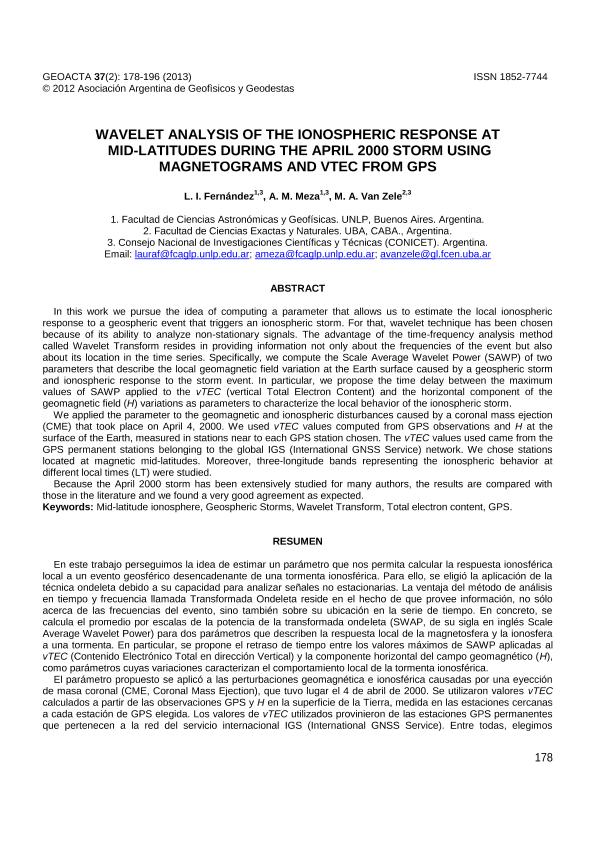Artículo
In this work we pursue the idea of computing a parameter that allows us to estimate the local ionospheric response to a geospheric event that triggers an ionospheric storm. For that, wavelet technique has been chosen because of its ability to analyze non-stationary signals. The advantage of the time-frequency analysis method called Wavelet Transform resides in providing information not only about the frequencies of the event but also about its location in the time series. Specifically, we compute the Scale Average Wavelet Power (SAWP) of two parameters that describe the local geomagnetic field variation at the Earth surface caused by a geospheric storm and ionospheric response to the storm event. In particular, we propose the time delay between the maximum values of SAWP applied to the vTEC (vertical Total Electron Content) and the horizontal component of the geomagnetic field (H) variations as parameters to characterize the local behavior of the ionospheric storm. We applied the parameter to the geomagnetic and ionospheric disturbances caused by a coronal mass ejection (CME) that took place on April 4, 2000. We used vTEC values computed from GPS observations and H at the surface of the Earth, measured in stations near to each GPS station chosen. The vTEC values used came from the GPS permanent stations belonging to the global IGS (International GNSS Service) network. We chose stations located at magnetic mid-latitudes. Moreover, three-longitude bands representing the ionospheric behavior at different local times (LT) were studied. Because the April 2000 storm has been extensively studied for many authors, the results are compared with those in the literature and we found a very good agreement as expected. En este trabajo perseguimos la idea de estimar un parámetro que nos permita calcular la respuesta ionosférica local a un evento geosférico desencadenante de una tormenta ionosférica. Para ello, se eligió la aplicación de la técnica ondeleta debido a su capacidad para analizar señales no estacionarias. La ventaja del método de análisis en tiempo y frecuencia llamada Transformada Ondeleta reside en el hecho de que provee información, no sólo acerca de las frecuencias del evento, sino también sobre su ubicación en la serie de tiempo. En concreto, se calcula el promedio por escalas de la potencia de la transformada ondeleta (SWAP, de su sigla en inglés Scale Average Wavelet Power) para dos parámetros que describen la respuesta local de la magnetosfera y la ionosfera a una tormenta. En particular, se propone el retraso de tiempo entre los valores máximos de SAWP aplicadas al vTEC (Contenido Electrónico Total en dirección Vertical) y la componente horizontal del campo geomagnético (H), como parámetros cuyas variaciones caracterizan el comportamiento local de la tormenta ionosférica. El parámetro propuesto se aplicó a las perturbaciones geomagnética e ionosférica causadas por una eyección de masa coronal (CME, Coronal Mass Ejection), que tuvo lugar el 4 de abril de 2000. Se utilizaron valores vTEC calculados a partir de las observaciones GPS y H en la superficie de la Tierra, medida en las estaciones cercanas a cada estación de GPS elegida. Los valores de vTEC utilizados provinieron de las estaciones GPS permanentes que pertenecen a la red del servicio internacional IGS (International GNSS Service). Entre todas, elegimos estaciones situadas en latitudes magnéticas medias. Por otra parte, estudiamos tres bandas de longitud que representan el comportamiento de la ionosfera a distintas horas locales (LT). Debido a que la tormenta de abril de 2000 ha sido ampliamente estudiada por muchos autores, los resultados se comparan con los de la literatura y nos encontramos con un muy buen acuerdo entre los datos publicados y nuestros resultados, tal y como se esperaba.
Wavelet analysis of the ionospheric response at mid-latitudes during the April 200 storm using magnetograms and vTEC from GPS
Fecha de publicación:
01/2013
Editorial:
Asociación Argentina de Geofìsicos y Geodestas
Revista:
Geoacta
ISSN:
1852-7744
Idioma:
Inglés
Tipo de recurso:
Artículo publicado
Clasificación temática:
Resumen
Archivos asociados
Licencia
Identificadores
Colecciones
Articulos(CCT - LA PLATA)
Articulos de CTRO.CIENTIFICO TECNOL.CONICET - LA PLATA
Articulos de CTRO.CIENTIFICO TECNOL.CONICET - LA PLATA
Articulos(IGEBA)
Articulos de INSTITUTO DE GEOCIENCIAS BASICAS, APLICADAS Y AMBIENTALES DE BS. AS
Articulos de INSTITUTO DE GEOCIENCIAS BASICAS, APLICADAS Y AMBIENTALES DE BS. AS
Citación
Fernandez, Laura Isabel; Meza, Amalia Margarita; Van Zele, Maria Andrea; Wavelet analysis of the ionospheric response at mid-latitudes during the April 200 storm using magnetograms and vTEC from GPS; Asociación Argentina de Geofìsicos y Geodestas; Geoacta; 37; 2; 1-2013; 178-196
Compartir




